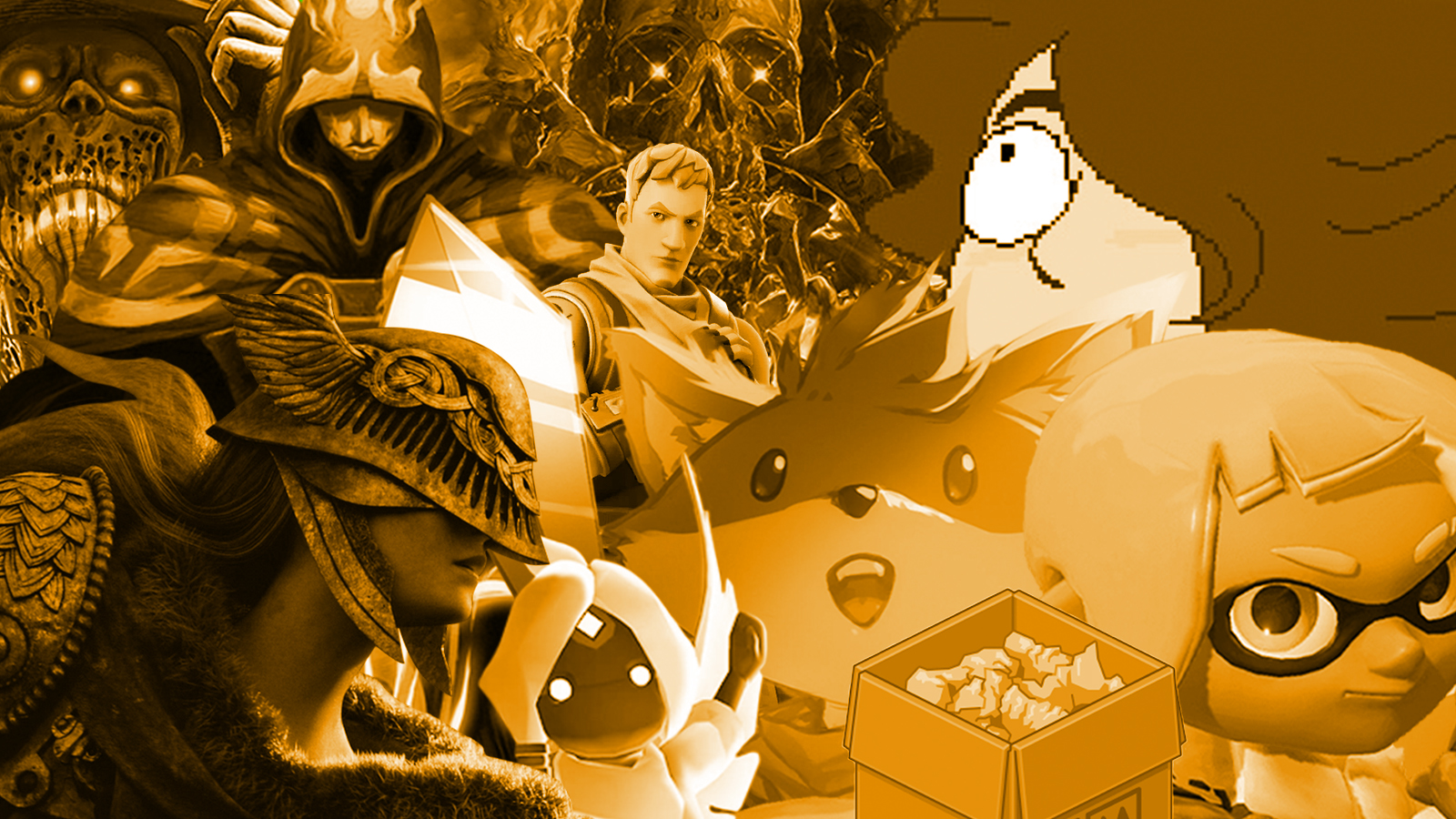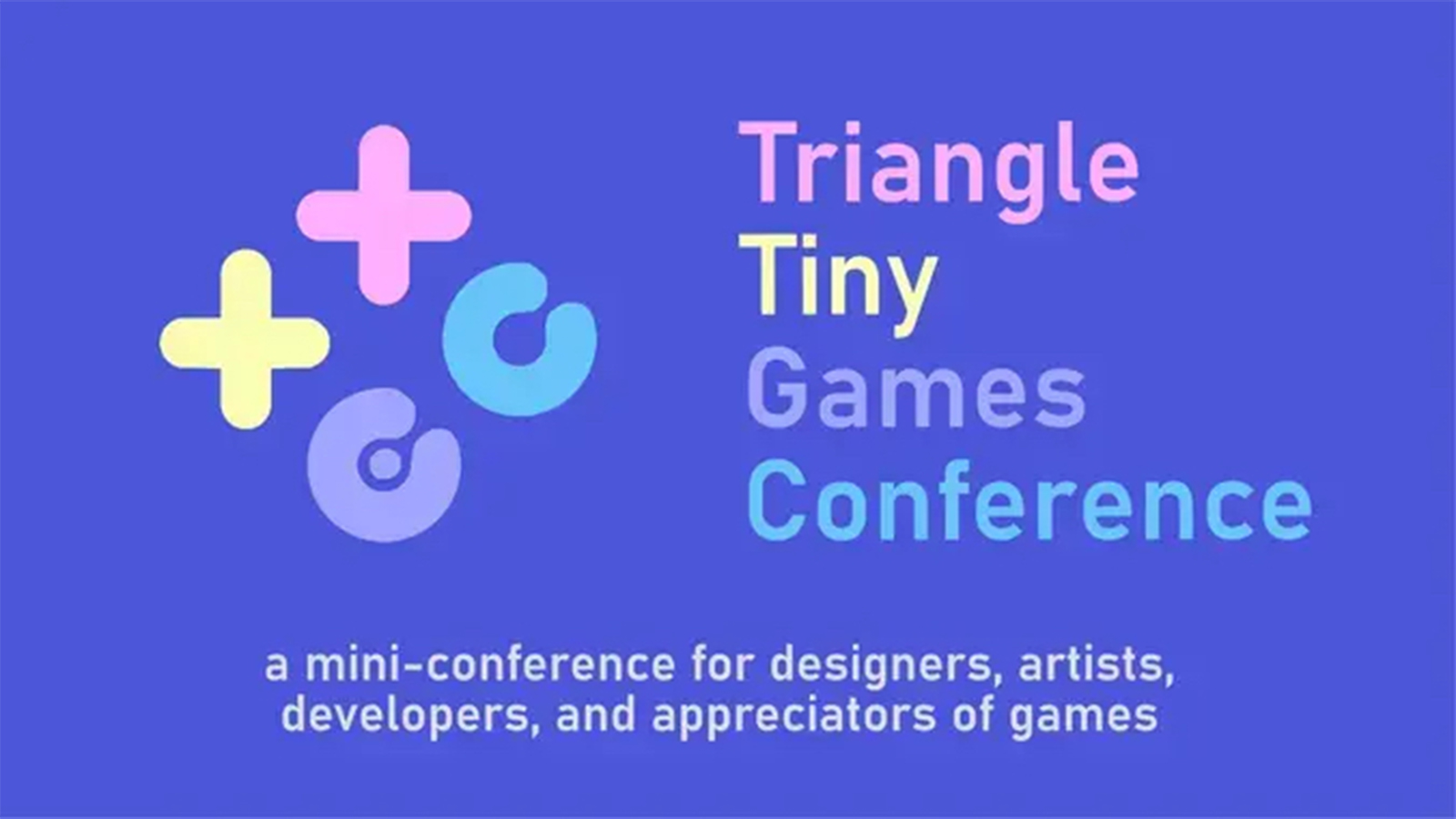am, yet again, forced to watch time slip by. My attention span being the block of swiss cheese that it is, the best games I played this year are the ones that stick out the most in my head as I look back — bite sized adventures with tantalizing depth or competitive experiences with incredible moments are, as usual, my go to. I got lost in the dizzying world of Elden Ring like a great many did, but I also lost a lot of money acquiring colorful cardboard upon learning that Magic: The Gathering had been hiding its greatest triumph from me. I reminisced about childhood, and teenagerhood, and when I get a moment to really look at where I am now I realize I am actually pretty content with it all. Ups and downs aside, this year did okay. Pretty good list of games, I think.
10
Sky: Children of Light
Like a moth to flame.

I’m going to start this one a bit weird: I don’t think Sky deserves this spot on my list. Not right now, anyway. It’s rife with more than a few technical issues, clunky interactions, and worst of all that pervasive gaming trend of a FOMO-capitalizing battle pass model. Let that all sink in before this write-up starts ringing like a full-on endorsement. Sky is also still in alpha. The mobile app version is, at the time of writing, 0.19.2. Every few months, a new season drops, and each new battle pass costs a whole ten dollars, not to mention other individual purchases that can cost up to fifty dollars apiece. I do not enjoy these things about Sky. And yet, I probably played it the most out of anything on this list this year.
Let’s take a step back: Sky is the latest game from thatgamecompany, the irritatingly-titled studio behind such indie darlings as Journey and Flower. It continues roughly down the same path they’ve consistently tread for themselves: softly spoken adventures, absent of anything resembling combat, and big on social features designed to foster kindness. I will always think about the emergent social experiences in Journey and how it grew from a simple adventure into something so much more.
In a lot of ways, Sky is thatgamecompany’s “Journey 2.” It features very similar controls and mechanics, right down to the ability to increase your jump height based on how much exploration you’ve done. Traversal is, for seventy-five percent of these games, the only challenge, and your reward for your perseverance is merely a method with which to bypass it. Sky and Journey both even share the third act introduction of a “scary zone,” right down to the floating dragons who lazily scan the area and attack on sight. Should they spot you, they give only a few seconds of warning before they attack, removing your jump height progress and leaving you bruised and scared of wandering into their sights again.
So if Sky is just Journey but on your phone, what is there to write home about?
Sky is all about its new social features. While Journey reveled in an absence of any real kind of dialogue between players, Sky opens this door a crack. There are benches where strangers can sit and chat with one another, with a candle serving as your method of interaction. Before you exchange flames, other players are seen as gray outlines, but should they extend their candle to you, you are both “lit up” for each other to see. You are then able to showcase your avatar and all the things you’ve collected to decorate it.
While Journey reveled in an absence of any real kind of dialogue between players, Sky opens this door a crack.
Your primary method of communication outside of a bench is the use of emotes collected from exploring the world. Each of the game’s seven main locales is dotted with spirits, who share their memories with the player. Experiencing these memories usually involves a platforming challenge or timing puzzle — some more monotonous than others — but it’s worth it for the reward of being able to have your character dance, or sneeze, or throw confetti into the air, since these are the more standard means of interacting with other players in this world.
Additionally, each spirit unlocked corresponds to new cosmetics that can be purchased with in-game currency, represented by nodes on a tree. And there are plenty to acquire: new hairstyles, new clothes, masks, accessories, and musical instruments — which you can actually play! Jam sessions with other players are actively encouraged. Filling out a whole tree of spirits and their respective unlocks also grants special rewards: unique hairstyles and masks from the Elders, called “Ultimate Gifts.” These cosmetics are often revered by players, as the work required to get them is not easy. It’s been almost a year since I started playing, and I’m only now getting close to my first gift.
So Sky has built an ecosystem designed to reward commitment and help people openly socialize. Sure, it’s a clunky, buggy ecosystem, but I can’t help but admire it. It’s clear thatgamecompany loves to try and bring people together, so while I kinda hate the battle passes and such, it almost feels like I’m making a donation to a church when I buy one here. It’s ultimately up to you to decide how much this game is worth it and what you’d like to do in it, but with the convenience of it being a free-to-play phone game, I found myself checking on it at least once a day. I’d send friends a free gift every now and then, run through a forest collecting currency, and see what new areas and quests each new season brought. The latest season is even a collaboration with musical artist Aurora, concluding with an in-game concert, so truly Fortnite has influenced everything now; but our virtual escapes can only get so meditative, so peaceful, as they slowly take over our lives. I’d happily pick Sky over most games, despite the hitches.
9
Unpacking
It’s the little things.
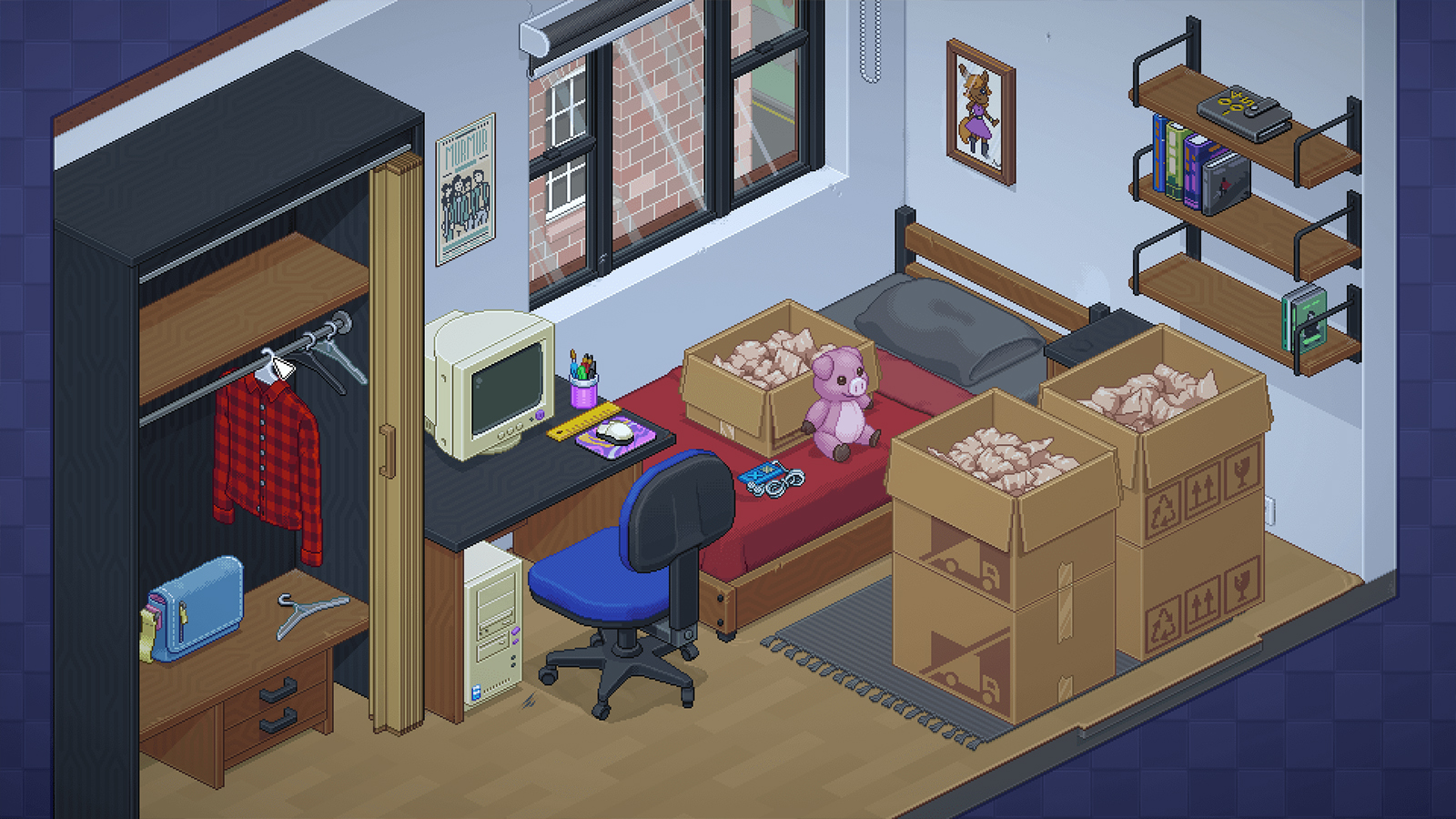
Unpacking is a late entry to my top ten list, but a welcome one nonetheless. Boxes of bubble-wrapped baubles and the enriching feng shui of a well-placed object are what make this game click, but its ability to tell a neatly wrapped story between the rows of books and silverware are what make it shine. If you’ve heard anything about this game, I’m confident the unreasonable amount of foley work done to bring each object to life is it, but the technical prowess on display is the kind that ultimately takes a back seat to the greater love within. Unpacking lives and breathes with an understanding that moving is a soulful experience, a bookmark in life, with our collections of things telling more than we might realize at first.
Unpacking takes you through every individual big move in a young woman’s life. It starts with a child’s room in a new home, where an empty bug cage with a large yard outside and a bevy of art supplies mark windows into the inner life of this main character. She draws, and she loves animals. Her next move seems to be a college dorm where her art supplies have received a major upgrade, and a massive beige PC has taken over her desk. Lots of her stuffed animals return, though not all, but the bug cage is back — and with a stag beetle friend inside! Shortly after she moves in with friends into a larger home, where context clues like a miniature statue of a cat-like character and a growing collection of fantasy novels reveal a budding interest in Dungeons and Dragons. The next move has her moving her things in with someone else, presumably a love interest, and while you can just barely find room for everything else, you can’t find any space on the wall for your diploma. Understandably, this is a sign that things won’t work out, and your next move is back in with your folks — bug cage empty, a drawing pulled out of one box being a fond farewell card to your beetle friend. In one very memorable use of the game’s singular fail state, should you try to hang a picture of you and your friends on the wall here, it will be marked as “not where that goes” and only when you hide the photo in the drawers or under the bed will the level complete.
This is how Unpacking goes. The story reaches its own little highs and lows through a uniquely zen medium, one that favors you drawing your own conclusions, but concludes none-the-less. Your impact on it is minimal but observing these moments through a small isometric window is a calculated beauty, one that opened my heart to the ideas it was selling with very little effort. Each moment in our lives is wrapped up in every move, and pulling them out to see how things have changed year over year, chapter over chapter, is special. Captured in each box is a selection of your own life to relive and the act of moving isn’t just about the new space you get to call your own, but the steps taken to reach it.
8
Fortnite
Look kids, I too can hit the griddy!
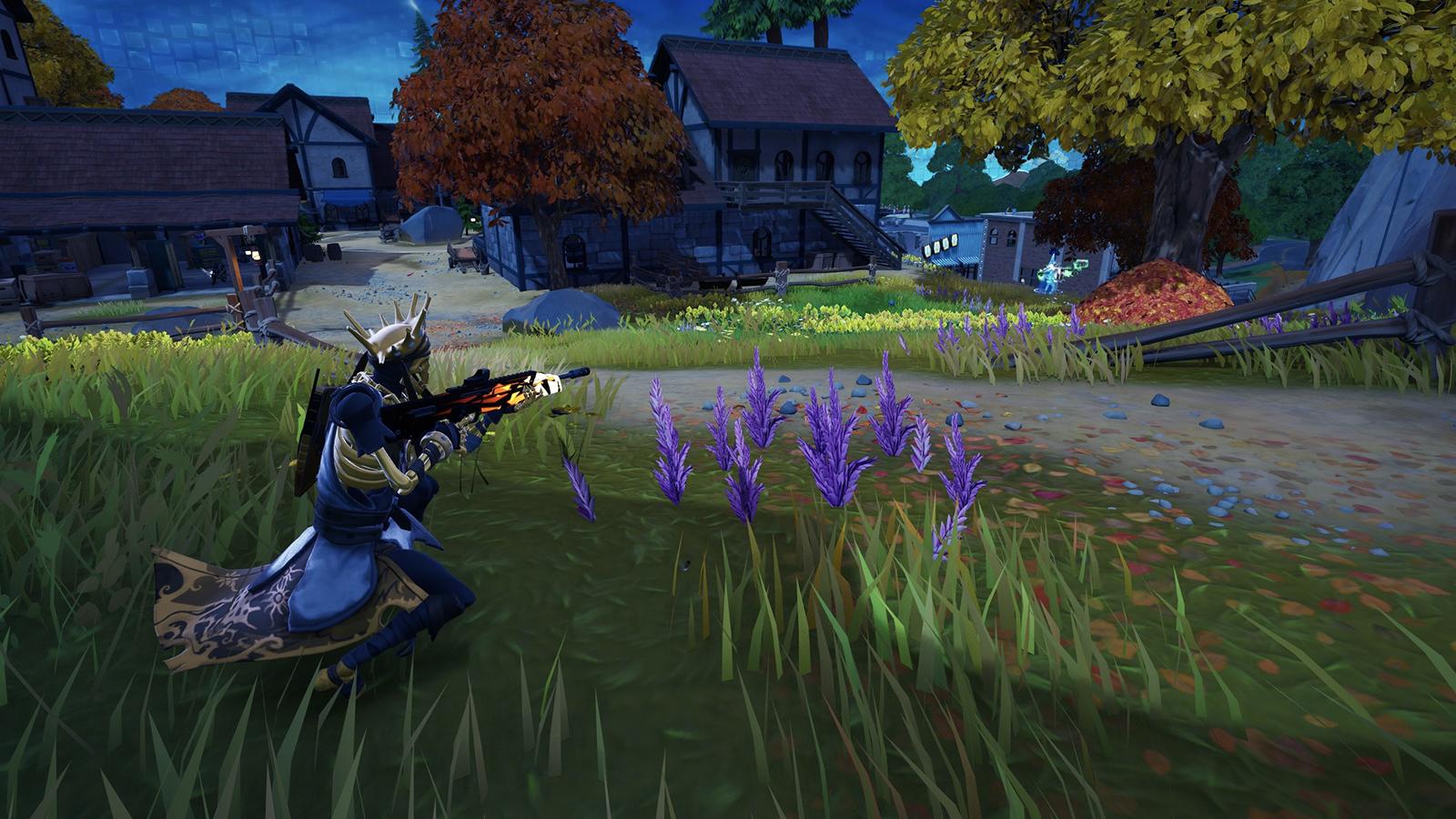
2022 is the year of Fortnite. Well, I guess a lot of years were the year of Fortnite. It’s kinda been the king of the playground for a while now, but this year something switched. It’s probably the addition of its new Zero Build mode, but I can’t say for certain. What matters is everywhere I looked, people who had sworn off battle royales, people who were turned off by the feel of Fortnite’s guns, people who had dismissed it for years as “kid stuff for zoomers” — myself included — all collectively realized with alarming simultaneity that Fortnite is good, actually. It felt like a wave of relief, the zeitgeist had been sucking in its gut for so long and nobody had to hide it anymore. Hardcore Halo fans, Overwatchers, friends and family — we all banded together on this! Fortnite is great!
I personally have never liked battle royales. Well, more like they never clicked with me. The random loot tables, the high initial skill ceiling, and the long stretches of waiting between short bursts of action pushed me away from the genre. Fortnite isn’t cured of all of this, but it does its best to alleviate a lot of it. For starters, I think a lot of battle royales tend to overvalue a “victory royale” and undervalue anything short of that. Fortnite instead doles out rewards like dime store candy, filling your experience bar and granting you all kinds of goodies just for exploring. I think simply walking across the map and interacting with objects and NPCs would sometimes earn me more experience than kills, or it at least felt more rewarding. Quests, both daily and weekly, earn you oodles of experience, and it’s genuinely not hard to complete the battle pass within a third of the time it’s active. I think Fortnite is making so much money at this point that they don’t feel a need to extort the dopamine drip of trickling its rewards out, because now it’s more like a fountain. Hell, completing the battle pass will earn you enough in-game currency to purchase the next one, with a little left over for that emote you liked in the shop.
[T]hey don’t feel a need to extort the dopamine drip of trickling its rewards out [...] it’s more like a fountain.
I like the skins, both original and licensed. Fortnite’s all encompassing pop-culture grasp is a bit silly, if not also a little terrifying — within my time playing I’ve seen RoboCop and Master Chief, real life sports stars and Goku, all inhabiting the same space as my silly golden skeleton man. They dance amidst the war torn landscapes to tracks by The Weeknd and Ariana Grande. This latest season has seen the inclusion of Doom’s titular Doomslayer, and within a week we’ll get Geralt of Rivia. But right now, we’re busy picking up anime powers and completing quests inspired by Shonen Jump’s latest hit, My Hero Academia. The point here is there’s a lot of this going on — sometimes I find it grating, but I think overall it’s kind of wonderful. Maybe Fortnite can’t grant every implemented IP with the same reverence as Smash Bros., but it can come pretty close sometimes. And when it does, it can even be charming. In the end, you have to respect the sheer level of customization available — recognizable or not, you can easily be whoever you want to be in this game.
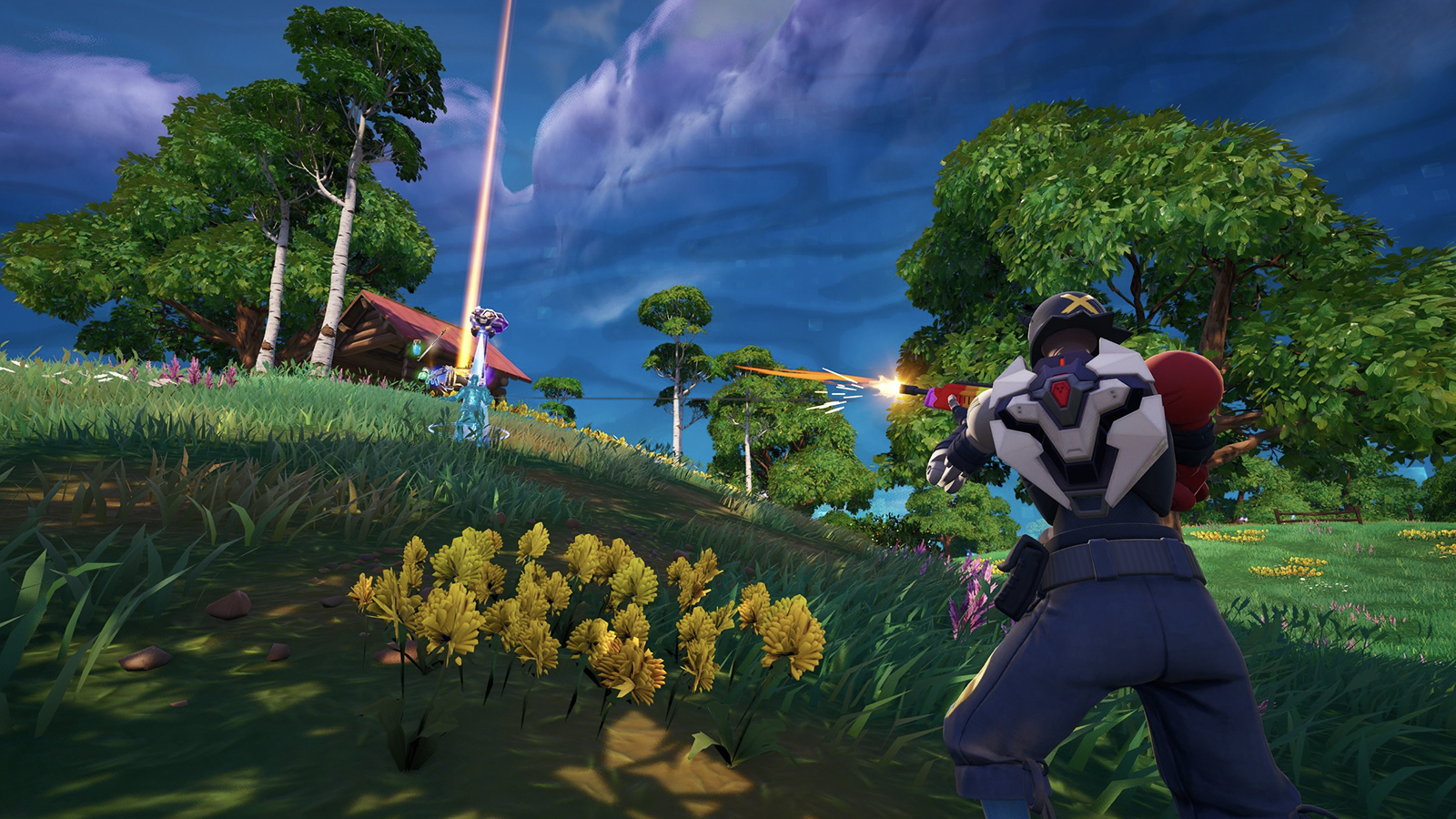
Ultimately, I think what makes this game great is that the highs can get dizzying, which are only amplified by the lows. So many moments of failure only bolster my resolve for a win, and a victory royale is so deeply satisfying that I keep chasing that moment. I’ve had them come easily, and I’ve had them be a hard-fought struggle. But the impact of that moment is always something incredible.
It’s down to five players, a 3v2 in our favor. A crack shot comes from a hidden enemy, with his partner speeding towards us with a shotgun. I launch a flare to sonar the area for my team, but it only marks the shotgunner. My aim is shaking under the pressure. You can see the exact frame things snap, and the final safe zone circle explodes into bullets and chaos. I’m chasing the sniper, a bad call perhaps, but I think my pals have their fight with the closer locked. Plus, the sniper won’t see me coming. Circle’s gonna get even tighter soon, so if I don’t move now I’ll miss this chance to sneak up on them. And there they are: using a rock as cover up on a hill, their aim still trained on the clearing where their partner is fighting mine, and I have a moment to steady myself. Boom. They’re down before they know what hit them. We mop up the other. Victory Royale.
7
HYPER DEMON
H̷̜̺̙̐̽̓E̵̞͚̞̔͌L̵̳̭̀P̵̯͙͋
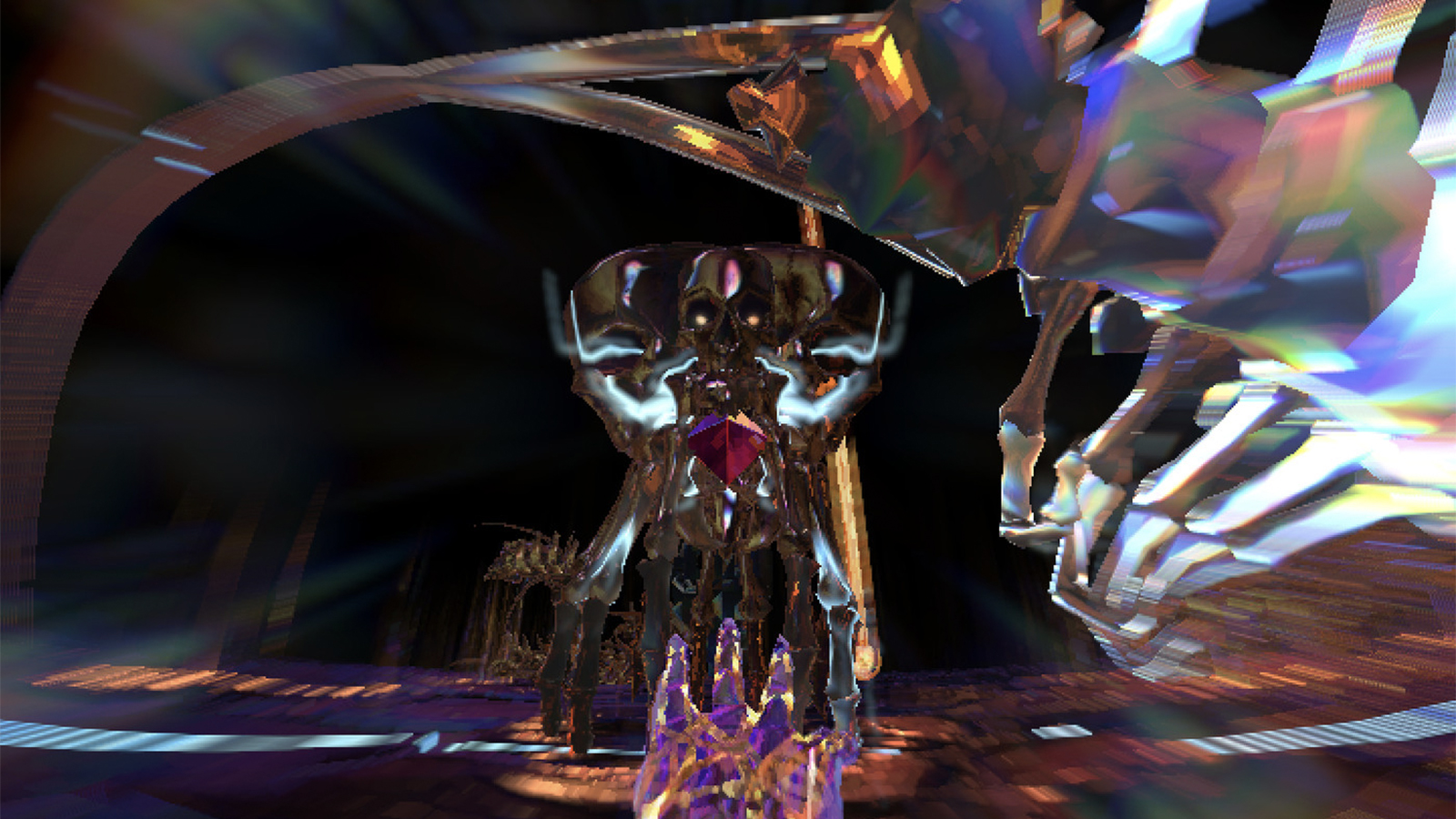
A disease transferred via passing glance, a weapon grafted to your psyche, a hell of your own creation, a victory of your own steadfast determination. The walls crawl with unthinkable creatures. The floor leaks insect appendages and your hand pulses with an energy that stings like thousands of knives. Your heart is beating like a piston, and your survival is constantly in question. You kill with reckless abandon, showering the battlefield in a paradoxical tide of neon blood and precious gems. The blood is power. The gems are salvation. Your weapon collides with the stones and forms ribbons of energy dispelling the horde in their path, but an extrasensory alert reveals more to come at your back. You have to keep moving. You have to survive. You have to destroy.
Devil Daggers released in early 2016, and it is still one of my favorite definitions of sublimity in the field of first person shooters — hell, in all of video games. It’s an inch wide and miles deep. “You have claimed the devil’s dagger. Last as long as you can.” HYPER DEMON can only be called a sequel, spiritual or otherwise, from the same team that had you stuck in a frantic square of perfect violence those six years ago. It is immediately similar, but the depth is pushed to its conceivable limits. If Devil Daggers is damnation, HYPER DEMON is salvation.
Your vision is warped in a vicious mockery of the traditional FPS camera, adopting an extreme fisheye lens to provide you a full 360 view of your surroundings. Your periphery is a constant vignette, no more will you be ambushed. It even flashes with the blood red silhouette of an assailant when something dares get too close to you from behind. The colors have evolved from the muddy browns and burning oranges of a barren hell to something more representative of a caveman’s kaleidoscope, with hues ranging from bright cyans to muddy chrome, with the ever-present crimson lurking. It’s far too easy to say this game is on drugs, and honestly that would be incorrect. This game is drugs.
I got stuck in HYPER DEMON for a whole evening, my focus unwavering against the sensory onslaught. Every time I died, I quickly reset and tried again. I pushed myself to keep trying. I didn’t necessarily think I could reach the leaderboard, but I wanted to try, wanted to prove myself, but I don’t think that’s actually why I kept going. I think I just wanted to keep seeing how this game managed to capture the incomprehensible nature of its place, its presence, and yet make perfect sense all the same. HYPER DEMON is a master class in making the impossible seem plausible. Its mechanics shouldn’t be so addictive in spite of itself. Its readability seems highly improbable, and yet it still is. Everything makes sense in the split second it takes to either absorb a gem or destroy it, to dance around an enemy to find its weak point or continue chipping at its armor. Like watching a universe of possibility unfold in front of my eyes, I stared at HYPER DEMON for hours, unpacking its puzzle box design, daring it to stare back. I still think it probably could, given enough time.
6
Magic: The Gathering Commander
Stacks on stacks on stacks.

I am a fan of trading card games, but I had long since convinced myself I’d never buy thin cardboard again. I’d never again dive so deeply into that money pit that I might emerge a pauper. I’d stick to virtual versions, where the prices stayed low and more packs could be earned for free. I had a Yu-Gi-Oh! phase — and a much shorter Magic phase — the latter of which ended when I came to realize the game was largely solved and the meta increasingly streamlined by people who had been playing for decades before I waltzed into the local game shop. But something this year surprised me — something that taught me how Magic: The Gathering could actually be fun under the right circumstances, and it brought me full tilt into a world of rich history and adoring fans. That would be the currently most popular and most social of its many, many formats, known as Elder Dragon Highlander or, more commonly, Commander.
Commander has a history almost as long as Magic itself. Magic, of course, if you aren’t aware, already holds the title for both the first as well as the longest-running trading card game and, consequently, Wizards of the Coast’s headline seller. The game has been around long enough to see dozens of sub-formats come and go: from basic formats limited to only the recently-released card sets to more obscure offerings, like one built around two opponents sharing a deck of the same set of cards. Commander started as a means to unify a fractured playerbase, and its setup is thus: one legendary creature serves as the face of your deck, the titular commander. Including this creature, you must have exactly 100 cards. None of these cards, save for basic lands, can share a name. Outside of a select few banned cards, any card from any set across the entire history of Magic is allowed. The final crux — and this is a soft rule but it is important — is to have more than two players. 1v1 Commander isn’t illegal, but it’s decidedly less fun. The goal is to have as many layers of interaction possible and to create an interconnected story between each deck.
I am lucky enough to have a friend group to usher me into this world, as has been the case time and again with other games, and I still nearly drowned in the possibilities. Commander encourages social play and experimentation above all, so cards that simply do something that you enjoy thematically are encouraged. I started with a pre-constructed deck built around a warlock named Prosper, who, flavor-wise, has made a pact with demons for wealth. He exiles cards — removes them from the game space entirely — but can later return these cards from exile, and with them comes treasure. He quickly builds speed into explosive finishes, as treasure can be spent on expensive casting costs, and I loved constructing his deck into a hellishly wealthy mogul theme. You could potentially steer Prosper a number of ways, focusing on exile interaction or maybe the token generation aspect, but I liked the image of my sinister pal sitting on a solid gold throne.
The goal is to have as many layers of interaction possible and to create an interconnected story between each deck.
My latest deck stars Obeka, a time-bending ogre prodigy whose ability is to — stay with me — prematurely end my own turn. It’s the kind of card text that earns me a few inquisitive looks, but the moment it clicks is always glorious. Magic, as ancient as it is, is built on several rules governing the flow of turns and the order things must play out. The beauty of Obeka is that within just her single ability, she interrupts and ignores this flow, and cards that say things like, “Summon this creature for free, but at the beginning of your end step you must sacrifice this creature,” now become, “I just summoned a creature for free. I have no end step.” These layers of interaction are what make Magic beautiful — make it the cultural touchstone it has become — and Commander enables them on a level no other format can in a way everyone can enjoy.
I haven’t had a lot of opportunities or reasons to get out of the house as of late, so Magic offering me the opportunity to meet new people at local game shops hosting Commander nights is kind of a godsend. Heck, part of the beauty of this game is its ubiquity. I’ve even been shocked at how often it turns out someone I knew had been a Magic player all this time without ever bringing it up before. It’s this multitude of players with unique deck building styles and a staggering 50,000 unique cards and counting that keep this game alive. You’re never short of new experiences, but, admittedly, it can be tough to break the seal. I’d recommend finding a friend who is willing to walk you through the basics and help with the trickier rules, or, barring that, watching the wonderful YouTube videos of Tolarian Community College. So if you have the time, give Magic a shot. Then, if you have the money, stick around for a while (just remember to buy proxies of the more expensive cards). And if you have the imagination and a keen tactical mind, build some of the coolest decks you can. I’ll always be up for a round of Commander.
5
In Sound Mind
Come now, physician, heal thyself.
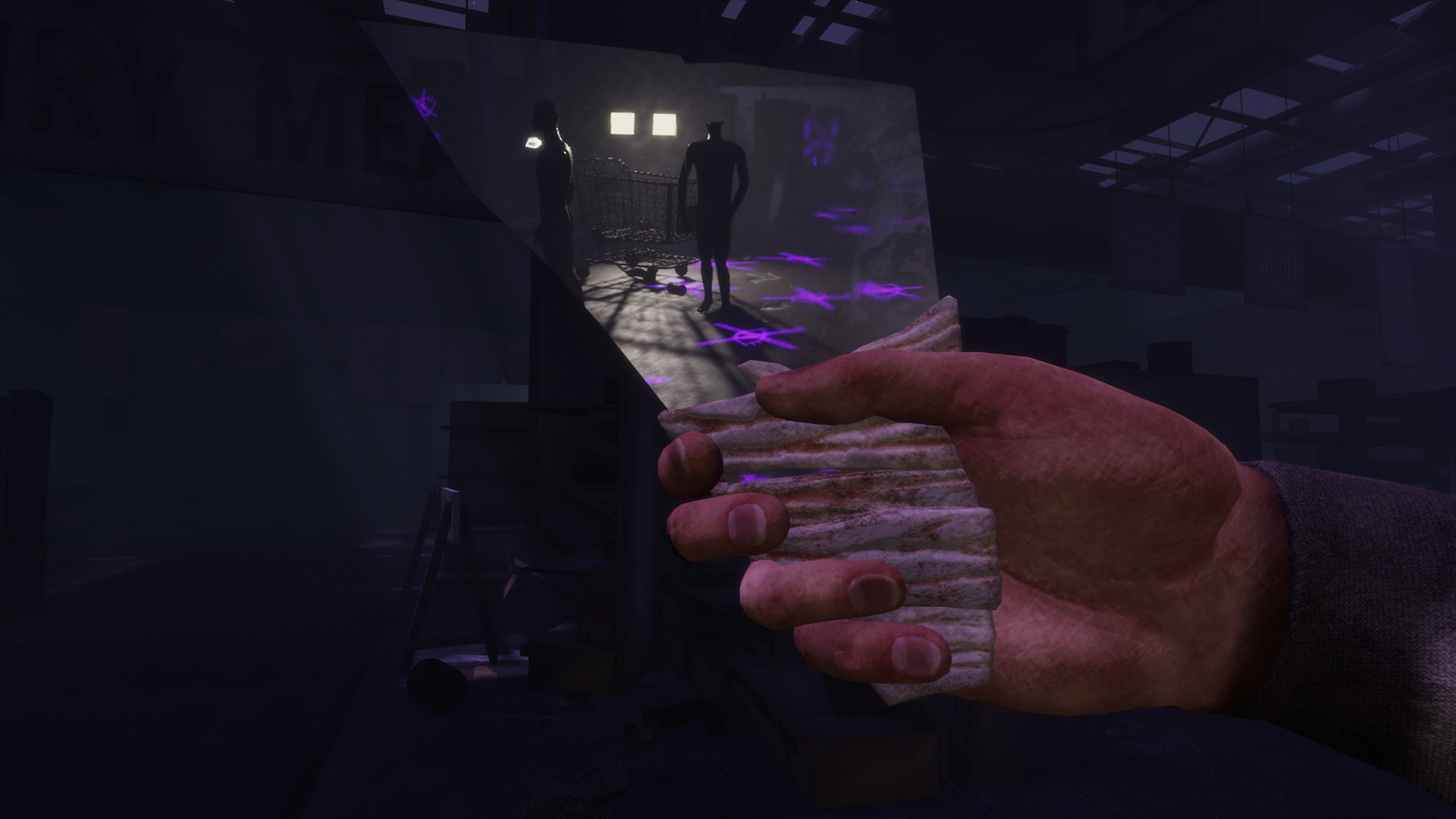
I think horror games have a hard time nailing their hook sometimes — you’re either a puzzly, shooty Resident Evil clone or you’re a Slender-nesia-type maze runner. My point is it can be hard to stick out of this crowd. In Sound Mind promises something I hadn’t seen before: horror with a ray of hope, a silver lining of light-hearted charm over more traditional survival horror gameplay, a message of kindness behind the scares. Every bit of horror media I can think of commits to the genre’s unyielding rule of tragedy — everything must suck, everyone must die — which leads many horror games to adhere to the established Silent Hill trope of “poor mental health equals monsters who won’t hesitate to eat you.” So what happens when you instead try to steer these tropes towards a positive outcome? How can you make horror end on a cheerful note?
You are professional therapist Dr. Desmond Wales, who, after losing patient after patient in a series of mysterious circumstances, awakens to find himself trapped in a nightmarish world, where your apartment-turned-office is surrounded by a flood of mysterious, shimmering, oil-slick ooze. Very little of this strange circumstance is immediately questioned, but it’s quickly surmised that this is a bad situation to be in and only by uncovering what has happened to your missing patients can you discover the source of this disaster.
You’re quickly introduced to — if not outright accosted by — both the proverbial angel and devil on your shoulder. Your devil, and primary antagonist, is a quick-witted, purple-hued zombie dressed like the neighborhood watch mascot. He quickly makes your acquaintance and his intentions known: he is going to kill you, once you’ve suffered enough at his hands. Your cat, Tonia, who can talk now, serves as your angel, an empathetic yet sarcastic guide through this world. And soon enough, you’re introduced to how this world actually works: via the recorded therapy sessions of your patients, you will relive their final moments in a bespoke level, formed from their deepest mental traumas.
One of your patients, Lucas, deals with PTSD from his time as a veteran and watches over a heavily wooded level as a giant walking radio tower, taking sniper shots at you if you’re seen. All the while, flashes of warfare appear in the forest, requiring you to dodge bullets, minefields, and the judging eyes of those witnessing your sudden traumatic episode. These moments of experiencing the patients’ insecurities and sicknesses make the game feel more akin to Psychonauts than Silent Hill. And even though each level ends with a boss encounter, it’s always more of a puzzle than a fight. It’s about saving these people rather than letting their issues eat them alive. Desmond ends each encounter not with a quippy, action hero retort, but with understanding and praise for his patients’ hard work in processing their trauma.
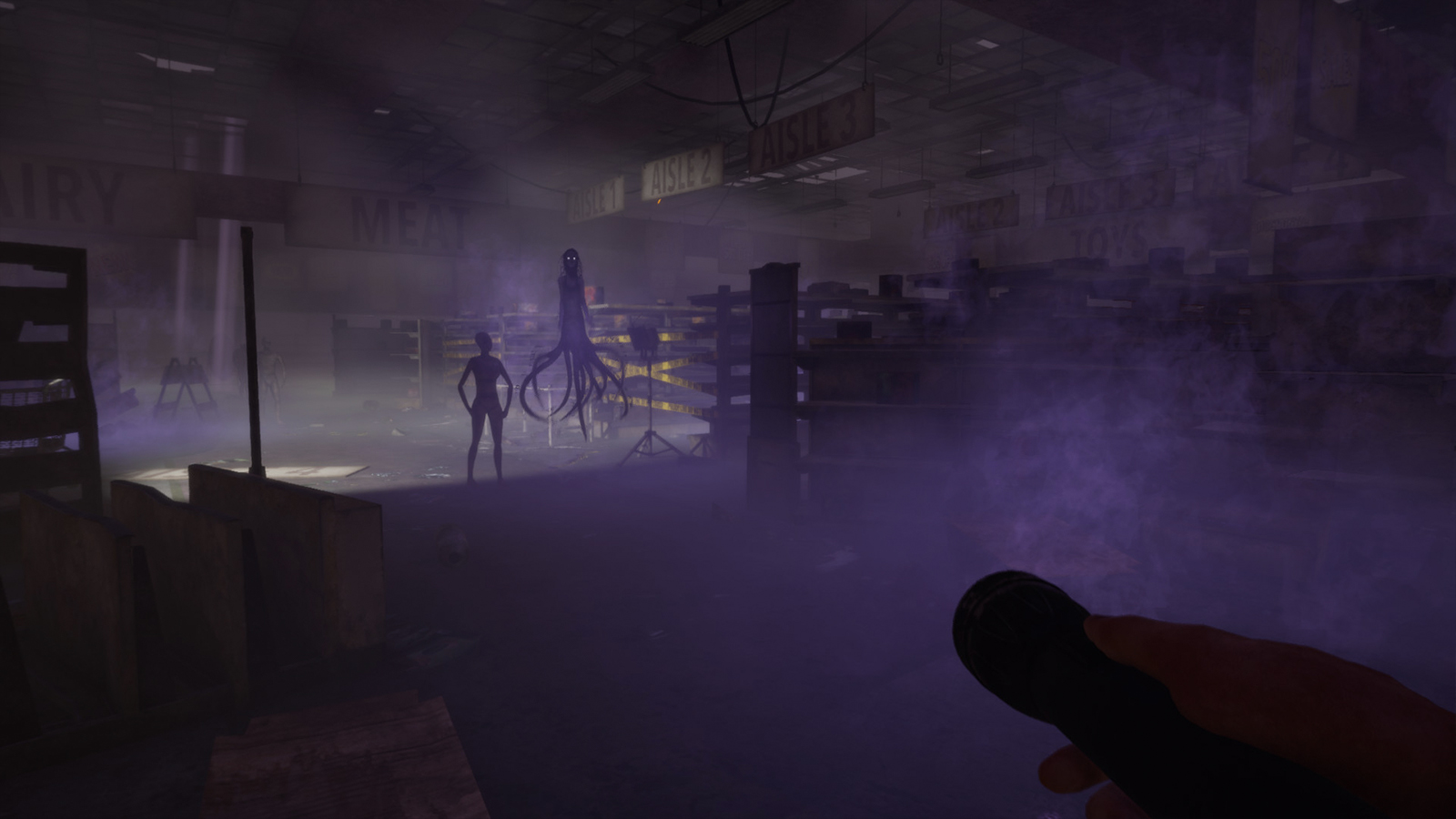
Another patient, Virginia, suffers from crippling social anxiety and has a level featuring mirrors and a monster mechanic not unheard of in horror, where simply looking at her triggers an attack. Her level also features mannequins that move when you aren’t looking — a popular horror game trope — but they feel earned here, as an extension of her paranoia. But in a great reversal of horror game expectations, no sooner than the first time they scare you do they show themselves to be overtly friendly: one suddenly appears behind you when attempting to open a locked door, holding the key for you. Should you turn around again after unlocking the door to thank them, it will be sitting down and shooting you an expressionless thumbs-up. Much later, one appears to lend a brief but impactful high five. Moments like this show how In Sound Minds brings positivity to a horror game in a way that makes it feel special.
And In Sound Mind has the solid gameplay it needs to support its ambitious thematic goals. The game is a wonderful pairing of light, survival horror combat with a majority stake in puzzle solving, with the added Metroidvania staple of finding new tools to unlock more levels from its hub world. It’s almost quaintly retro in this way, evoking memories of Banjo-Kazooie and N64-era Zelda more than any Resident Evil.
Despite all that, you shouldn’t let your guard down: In Sound Mind has more than a few tricks up its sleeve to remind you that it’s still a horror game. The game’s gleeful antagonist has a penchant for scaring you by turning up just outside your periphery before vanishing into smoke. He’ll constantly harass you throughout the game from turning up in doorways where he wasn’t before to watching from a cliff off in the distance to comically tip-toeing across a hallway like a Scooby-Doo villain. He’ll often call from nearby phones too, just to kindly remind you that he’d like you to suffer as much as possible under his torment.
Each level’s monster is an excellent rendition of specific horror game concepts while also being a beautiful reminder of their representative character’s psychoses. And while the horror of the experience erodes over the game’s playtime, moments throughout were still very effective at eking out yelps of terror. The wackiness of the mental playspace these levels take place in keeps the uncertainty at an all-time high, and not knowing exactly what the game would throw at me around each corner is a hallmark of its design. In Sound Mind capitalizes on being a solid horror game forcibly injected with positive vibes and resounding praise for the act of going to therapy, if only because it proves that at the end of it all, it does get better.
4
Tunic
Reverence to those who came before.
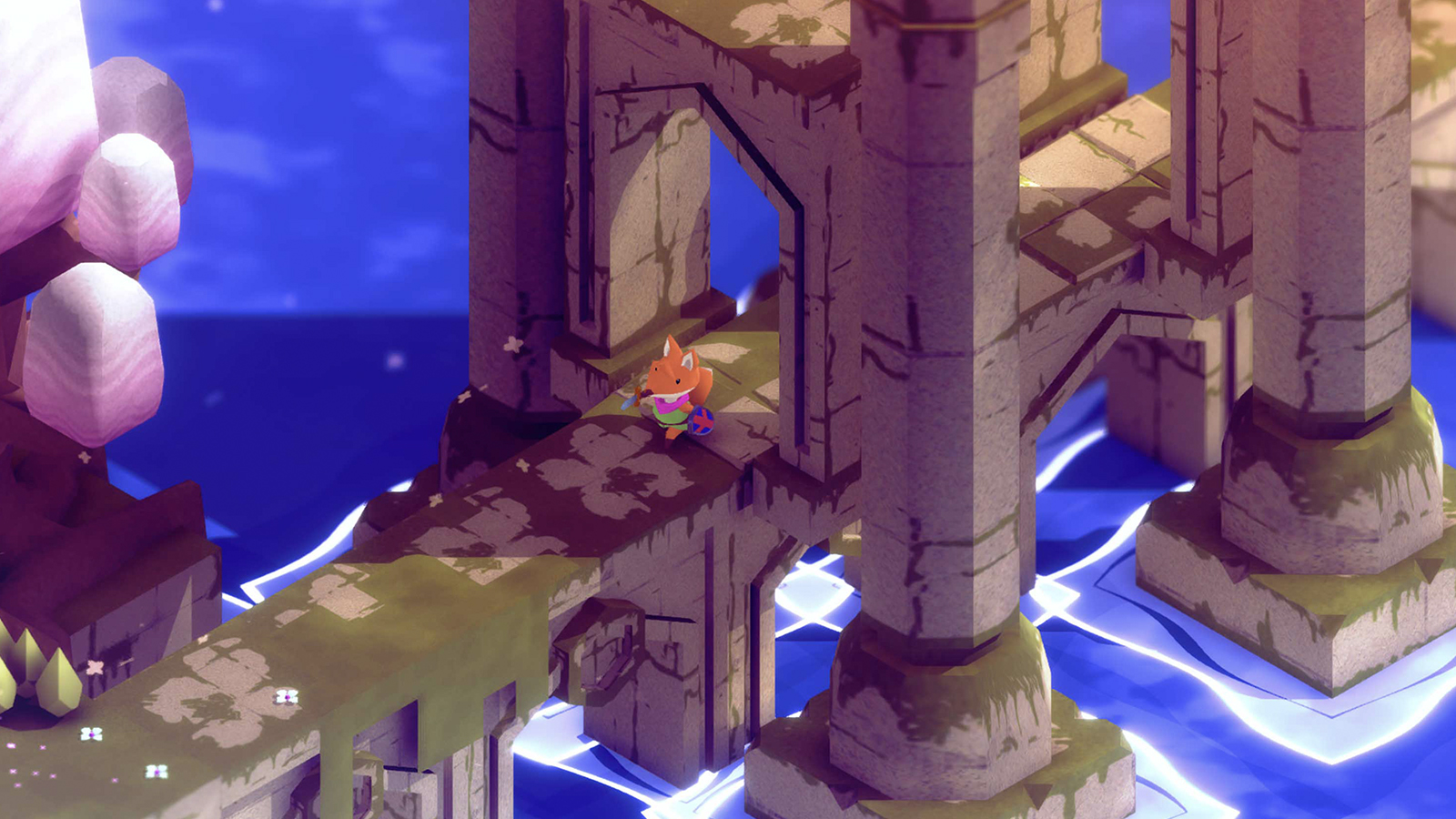
It’s one thing for a game to make me write notes on pen and paper — that much is already a special quality so rare these days. It’s another thing for a game to make those notes, without me noticing, into beautiful artwork. Tunic is a lateral puzzle game, or a metroid-brainia, or whatever we end up calling the sliver of puzzle game pie that currently holds such lofty titles as The Outer Wilds and Return of The Obra Dinn. I mention that first hand as not knowing this fact kept me from diving in immediately, thinking it was simply like an old-school Zelda meets Dark Souls sorta thing. No friends, Tunic is so much more. Tunic doesn’t just aim to capture the difficulty and wonder of long lost adventure game titles, it aims to capture the mystique — the fogginess of an NES cartridge found in the street with no label or manual. Tunic is as much dungeons and dragons as it is making sure you catch the latest Captain N so you can decipher that secret message with your decoder ring — except the episode is in Japanese and you need to rebuild the ring from pieces scattered around your neighborhood.
Spoiler Warning
It’s impossible to talk about Tunic without talking about the ending and what makes it wonderful to me, so I am going to make this the spoiler warning. If you have any interest in completing this game but haven’t done so yet, turn back now.
Tunic opens with your foxy hero character awaking to a land in turmoil. Monsters roam free and the ethereal princess is trapped in a fractal prison of strange power, and as you might expect, it’s up to you to save the world. Your first hint that this isn’t a normal video game adventure is the acquisition of a page to a physical manual, and with it the knowledge that on command you can zoom out from the CRT you are playing Tunic on to flip through said manual. Its pages are written largely in strange glyphs, but the images are enough to explain a few things that weren’t obvious before. Early on, it’s things like “holding the dodge button starts a sprint” but before too long you learn that holding the interact button (for long enough that no one would stumble into this on accident) has your hero channel energy through themselves to activate certain nearby machinery. Items are also completely untranslated and their uses aren’t obvious until you experiment with them, necessitating moments of pure discovery and delight.
Tunic is as much Dungeons and Dragons as it is making sure you catch the latest Captain N so you can decipher that secret message with your decoder ring
Tunic might look mostly like a classic Zelda game but it actually plays a lot like your standard souls-likes, complete with stamina management. This might be the one hang up for most but there is a handy cheat menu should you find the combat a bit too grueling. I personally made it through one boss fight after several tries without it before I started turning on “no-death” mode for each boss encounter. Said boss granted me a red crystal which I recognized from several images in the manual and a similar looking slot in a structure near the princess’ prison — sure enough, returning to that area let me place the crystal in said slot. The adventure only starting, I ventured through dungeon after dungeon, discovering more areas and more mechanics, until I finally freed the princess, and took my place — on the end of her blade.
The princess awakes to bring about calamity. Every boss was built by a society trying to prevent her awakening, and every fox hero is a manifestation of her magic trying to free her. The monsters aren’t hostile because they’re monsters, they’re trying to stop your quest and keep their land safe. Your death brings you to a spirit realm full of other fox heroes, some hostile and some locked in a state of melancholy. But it’s not too late. Through sheer will and determination you can fight your way out of the spirit world, you can earn a new power that unlocks more ways to explore, and you can challenge the princess in combat to end her reign of terror. This is all possible entirely on your own laurels.
But Tunic is so high on this list because it’s at this point that it completely escapes the orbit of its contemporaries and becomes something completely new. A new mechanic, one that had always been available to you but never explained until you find the right manual pages, emerges as having been baked into the game world from the very start. Scattered around the game have been moments where you could interact with hidden puzzles lined and dotted across the landscape and finding all of them, both within the game and without, is key to a moment wholly unique to this genre. If you succeed in this task, you get to bypass the final boss entirely, and propel the game from a place of simple adventure, to a moment of epiphany. That much I’ll keep secret, but it’s a moment worth every step of the journey.
3
Elden Ring
There and back again.
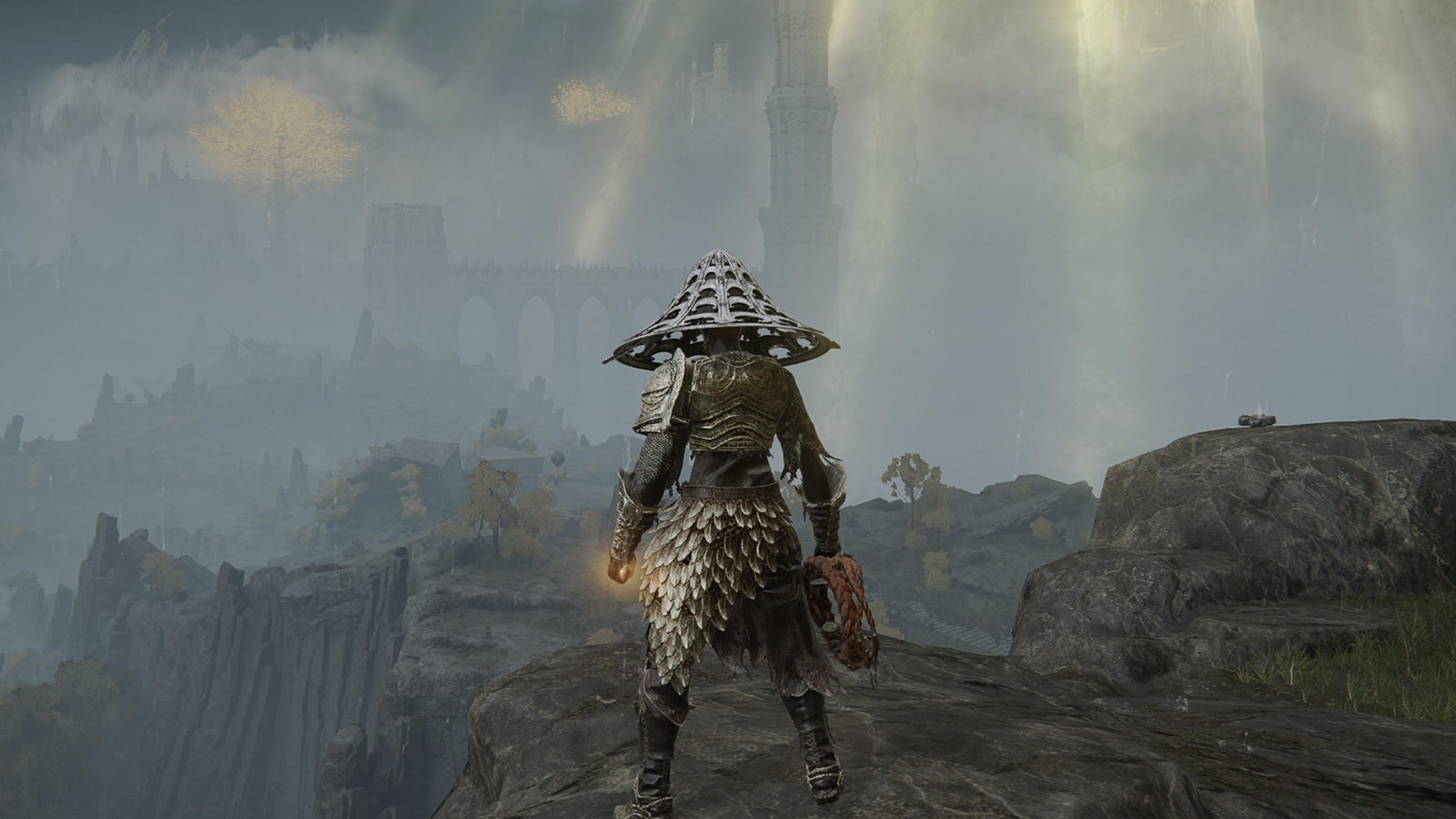
I am among a decently-sized group of gaming folk who find the FromSoftware library exhausting: an endless source of ill-intentioned discourse at worst, totally inaccessible, finely-crafted works of art at best. Like window shopping for Ferraris, I always looked upon these Dark Souls and Bloodbornes with a longing for what could never be — I so enjoy bleak atmospheric worlds, thematically and mechanically rich interactions, and deep pockets of lore hidden through plain context, but the minimum of necessary skill required to pull the fragments of joy out of the experience was always too high a bar to clear. Elden Ring was finally the game they made for me: a Dark Souls game with gracefully sprinkled cheese strats, a community open to beautiful moments of cooperation, and a world both captivating and subtly haunting. It consumed me, as it did many, for the months following its release, and when I finished it, I only found I had missed so much. Elden Ring is a boundless adventure of nigh unparalleled depth, something I hope future open world games learn from, and something I desperately hope FromSoftware themselves return to. No other game this year had me thinking, “I am playing one of the best games ever made” the entire time I was strapped in.
Over the course of my adventure in The Lands Between, I faced the usual litany of roadblocks: I had a couple of trip ups smashing my face against the game’s pre-eminent wall Morgott, and I may have attempted Astel, Naturalborn of the Void more than several times, but I never felt stuck. With the former, I was kindly guided by my FromSoftware addicted brothers that there was actually a convenient path that completely circumvents the Morgott fight. I walked away from his arena, previously thinking it was the only way through, and instead explored a full map that extended past his castle and encompassed a swampy lake area. This is just the beginning of how Elden Ring embraced me. I found an entire new dungeon that was more my speed, and more importantly, a spell that would define my entire career as would-be elden lord: frenzied burst. The spell itself is not dissimilar to the abilities of one Cyclops of X-Men fame, though flavored to fit the world of course, wherein your character groans in horror at the flame of madness building behind their eyes before unleashing a laser beam with the range of an anti-vehicle rifle and the impact to match. This was to be my partner throughout the game, as it turns out dealing half a health bar of damage to any one enemy before they even know you’re there and then dealing the second lethal blow before they can slowly amble their way towards you is just wonderful in a game that values its high difficulty spikes. I approached every encounter in a “how best do I laser this thing to death” way and built my character all around this, from increasing stats that increase my laser’s damage, to finding anything that might make its one downside — a horribly long cast time — a bit easier on my panicky reflexes. I genuinely never tired of this, and after exploring several areas that I had no business exploring given these strats, I was frankly overleveled and wiped the floor with Morgott using carefully placed laser beams and a horde of spectral wolves.
You see, Elden Ring’s supposed “softness” isn’t a problem, or a weakness — it’s just FromSoftware finally opening their games to a different kind of player. The kind that wants to work smarter, not harder. My brothers and I found a particularly tough battle against one of the game’s hallmarks in difficulty, Malenia, and instead of repeatedly ramming our heads against that wall I started brainstorming solutions that involved testing particular weaknesses, exploiting staggers, and trying new defensive abilities. One of my siblings, almost incredulously, asked me if this was how I approached all games, and when I said kinda, he had a sudden realization as to why I had bounced off of so many other titles in this genre. I don’t mean to toot my own horn, but I think I finally earned their respect that day. One who was probably on his 5th playthrough of Bloodborne and another who had nearly beaten Sekiro without dying. This may be a pretty big reason why I’m holding this game aloft. I don’t intend to smash through walls, I’m more of a dismantler — I work brick by brick. Elden Ring was just the first to formally, openly, support this approach.
It helps that the world is so easy to get lost in, that only mere trails of wispy golden smoke are there to guide you. It helps that its greatest moments are undoubtedly spectacular and full of wonder. The first time you descend a mysterious well in the woods and find yourself in a cave, seemingly more vast than the world above, with a ceiling covered in stars? You never forget these moments. It helps that by virtue of all of these reasons and more, I found a complete character arc in my trigger happy laser sniper weirdo. When he came across the origin of his power, three burning fingers that lay dormant deep in a catacomb, the ones his only traveling companion urged him not to speak to, he hugged them. The madness had chosen him and his only path forward was madness. He was to bring about only destruction, and that suited me just fine. I collected every Frenzied Flame spell I could find, burned paths through whole villages, crumbling ruins, and frozen wastelands, and brought about an age of unending fire. The crazed blaze, you might say. It felt right. It felt complete. It felt like, despite the fact that there are 7 total endings and a multitude of events and plotlines I had missed in this playthrough, this was Elden Ring’s intended path for me. I can’t explain how. There’s a magic in this game that eludes me. I’m actually going to go in for a second run any day now to see if I can’t recapture it. Maybe I can manage without the laser beam, we’ll see.
2
Perfect Tides
Sooner or later.
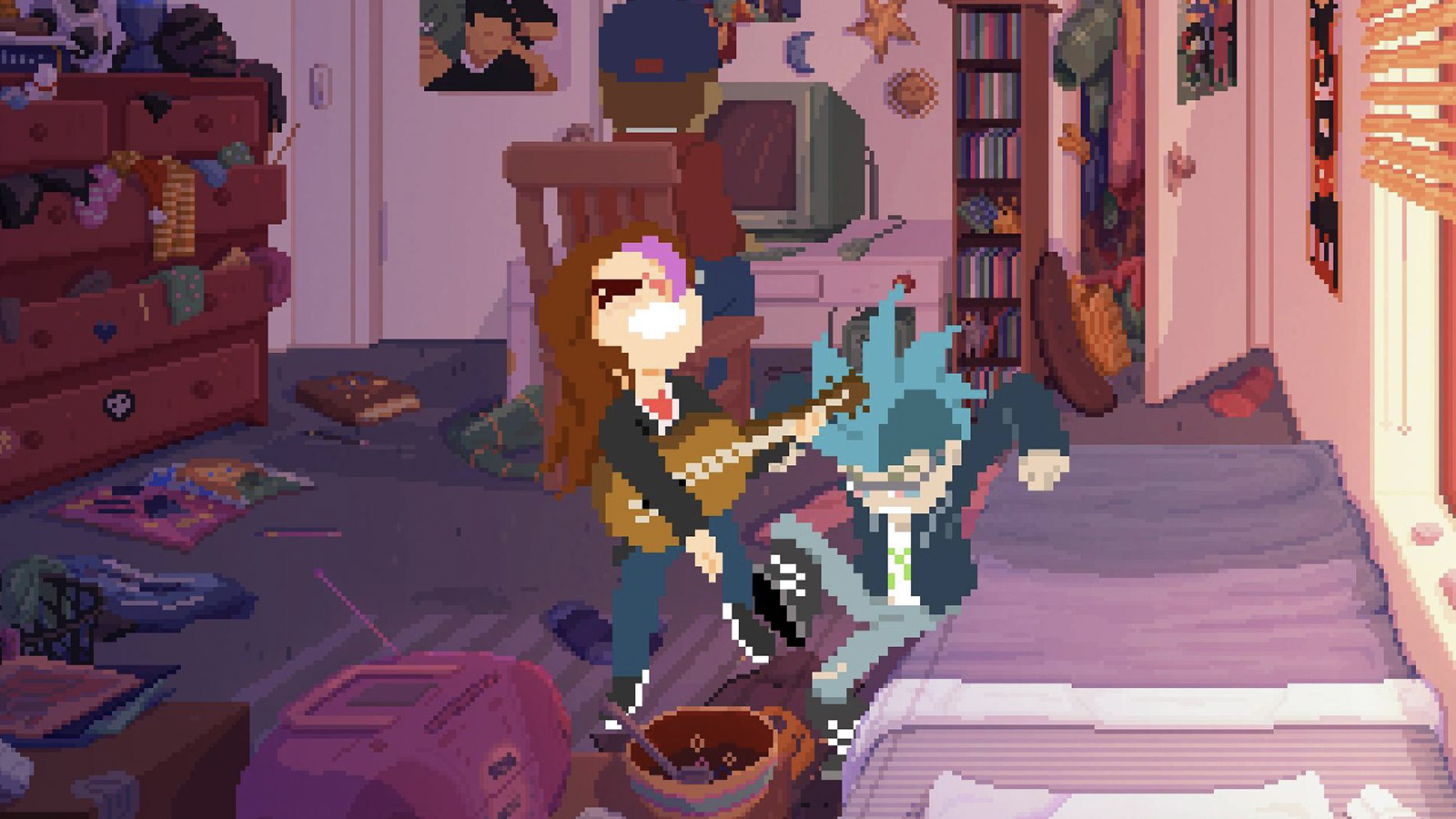
Trigger Warning
This game deals with a lot of teenage struggles, including sexual assault, drug and alcohol abuse, and general social anxieties. This write up leaves out a lot of those details, but I would be remiss to not mention them.
Perfect Tides opens with the biggest high school bombshell possible — on the ferry ride from the mainland to the island you call home, your best friend, over the last weekend, lost her virginity with an upper-classman. Of course, that’s not a huge deal, why would it be? Just because she’s prettier, more popular, constantly treating you like a kid — it’s totally chill. It’s the total opposite of chill. Mara is in 10th grade, the year is 2000, summer is right around the corner, and nothing is more important to her than appearing like an adult, and finding an ounce of connection in this turbulent teenaged world.
You spend the last of your school days surrounded by kids who seem to have it figured out, who know their people and their place. You fire up the computer every night to log into AOL on a dial-up connection to talk to friends in fan-fiction message boards who actually understand you — who might even share the first and only genuine crush you’ve had. Your mom struggles with being a single parent while your brother spends his days on the couch, supposedly job hunting off-screen, resenting your freedom while you resent his. There’s palpable anxieties present everywhere you go, people who might take advantage of you, or people you once admired suddenly becoming vulnerable, shattering any remaining illusions you might’ve had about adult life. I have never been a teenage girl, I was 6 years old at the turn of the century, and I’ve only ever visited beaches as a tourist — but the reality of every teenage experience is expressed so perfectly here. Meredith Gran excels at telling stories that pull no punches — no weight left unlifted, nothing obscured for your safety, it’s raw — it’s gut wrenching, euphoric, and moving.
[T]he reality of every teenage experience is expressed so perfectly here.
Gran, previously best known for her work on the webcomic Octopus Pie, bites and pecks at parts of my soul I had long forgotten about. Being a teenager is awful for so many reasons — I think everyone can attest to that — and I can still connect to every single emotional beat as Mara. It all felt so real, because I had those same emotions constantly running through my own head. Everyone has it all figured out but me, I figured. In the end, key decisions in Mara’s life are in your hands, but it won’t stop some of the same traumas from playing out. You can do what you can to save friendships, make peace with a broken family, help someone else in need when all you want is for someone to help you — in the end, you can only help her to help herself. I played Perfect Tides from beginning to end twice trying to find every bit of dialogue and detail I could, and seeing how outcomes changed from decision to decision. While a lot more of the game is on rails than not, there is a happier ending available. Not one where Mara is fully self-actualized, but one where Mara realizes self-actualization is both possible but also not going anywhere. You can’t avoid nearly getting assaulted in an alley, you can’t avoid falling in love with Jason, you can’t avoid fighting with your brother — but you can find that life moves on, and pain dulls with time. High school, and by extension all of teenager-dom, is fleeting.
The game’s final act involves taking shrooms with your childhood best friend, a friend that spends a third of the game mad at you over a fight that breaks out at the end of the first act. It asks you, in a subtle way, to ready an MP3 file in the games folder for this moment — I chose the Harvey Danger cover of the The Beat’s “Save It For Later,” an oft-covered whimsical tune about begging life to slow down for a moment so you can have a chance to catch up. Its original writer Dave Wakeling wrote it as a teenager, and says as much. It’s a song that meant a lot to me in my teenage years. I was treated to a pixelated montage that eerily synched up to my chosen tune of the two friends reconnecting in their psychedelic haze, dancing together in the walkways of their homes, exploring the island they grew up on together, and realizing — as I once did — it’s never bad forever. Not ashamed to say I cried at this, as I almost did at several other moments throughout the game. That’s what Perfect Tides is to me now, several moments of pure catharsis so rarely found in any story once, and I am now desperate for the sequel.
1
Splatoon 3
Staying fresh.
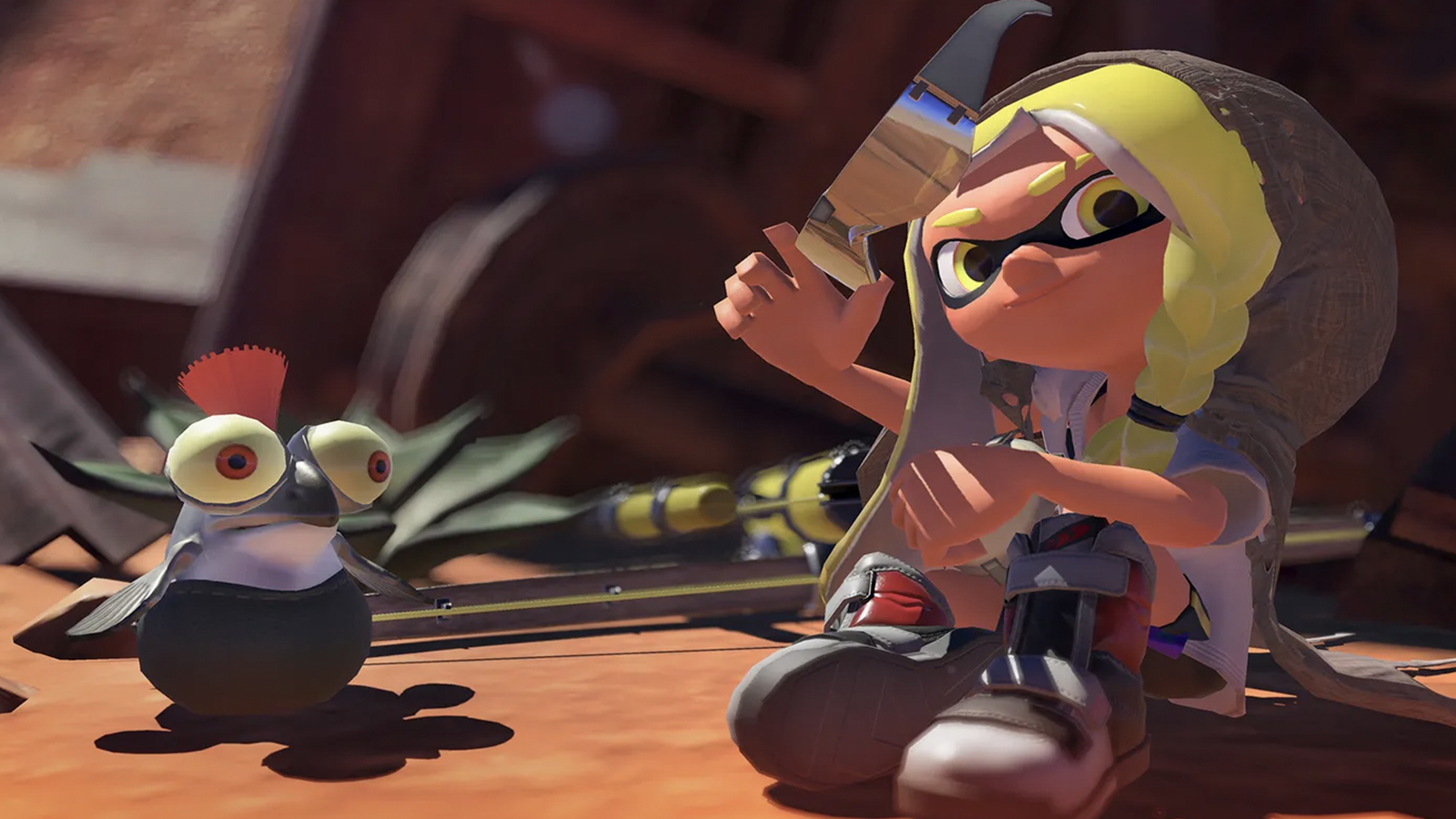
Between continuing the franchise’s surprisingly engaging plot, rebalancing its multiplayer gameplay, and introducing an off-beat trading card game that I might’ve played more than the rest of the game, Splatoon 3 continues a tradition of excellence in its tight, colorful niche.
I have always been impressed by Splatoon. Ever since its initial release on the Wii U, I’ve adored its airtight design and keen sense of culture,and Splatoon 3 continues this trend in beautiful fashion. No need to fix what isn’t broken, just polish what works to a mirror shine.
If you’re not familiar, Splatoon is best described as “Quake meets Jet Set Radio”: a perfect marriage of fast-paced gameplay and jazzy-infused style, evoking the history of hip-hop, skater punk, and the rebellious youth culture of urban Japan. The Splatoon games are so rooted in this aspect of their world-building that their music tracks are all attributed to one of several in-universe artists. Musical artists have their own signature styles and melodies to keep them distinct, while still sharing that same quality of feeling like music from a sea creature who evolved to learn what a synthesizer was. And every iteration of Splatoon gets its own group of “idols,’’ musical celebrities that hold a great deal of influence over modern Inkling culture: performing monthly Splatfests, announcing updates to the current state of the multiplayer, and playing their own part in the story writ large. And Splatoon 3 is the first time we’ve seen these idols come in a trio: Shiver, Frye, and Big Man — the latter we stan without question.
It’s also the first time we’ve gotten a single player Splatoon campaign that actively tries to figure out what they are really doing with the evolving story of this series, tackling some of the major questions left unanswered in previous entries. Deep divers into Splatoon lore understand one thing pretty well: this world is a post-apocalyptic one. Mankind died out long ago, and sea creatures have risen to the task of living in our old mess. In Splatoon 3, the game dares to show us humanity’s final moments and what dangers might still lurk in underground bunkers, left over from a society that had tried harder than the rest to survive. I don’t want to spoil too much but the finale is a doozy — both in scale and spectacle — and leaves me very excited for more.
But the multiplayer is the real reason to buy a Splatoon title. It’s a hyperactive, split-second, focus-driven affair. Shooting works as it does in other shooters, but your projectiles create trails of ink on the ground as they fly, and bound to the left trigger is the series’ iconic “swim form” that swaps you into your cephalopod mode for swimming in ink. You have to swim in your own ink both to reload and move faster, so territory control is important, necessitating defensive players who protect and keep your side of the map inked for effective retreats. This, of course, means there are flanking oriented weapons that are better at sneaking into these areas, killing backliners and keeping enemy options limited. Other weapons are built for skirmishing, living somewhere in between the front and back lines, focusing on keeping the enemy team either distracted or dead. Preferably both. I’ve often agreed that what keeps a multiplayer shooter interesting is a deep exploration of movement and objective. It’s the beautiful melding of these ideas throughout Splatoon that keep it mesmerizing — shooting (and therefore inking) is the objective, completing the objective yields more movement, movement allows more shooting.
Maps are still limited to two per mode swapped out every two hours, but one of the grander highlights of this entry is the ability to skip the announcement of the map change and keep playing without interruption. Previously considered one of the major hangups of the series, this is such a welcome adjustment. Modes vary from the iconic turf war, to the more competitive offerings like Tower Control and Splat Zones, Splatoon 3’s take on payload and king of the hill game modes, respectively. The series’ relatively recent addition of Salmon Run, a co-operative horde mode, also returns — zombie-esque salmon creatures wade ashore grim rusty locales and must be fought off with a deeper emphasis on teamwork and efficiency. New “Salmonids” appear in 3, as well as new special events and maps for this mode. When you’ve finished a tough bout of intense multiplayer matches, the new included method of cooling off is with Tableturf — I am sparing no words here when I say the Splatoon digital trading card game is far better than I expected. I sometimes open the game just to play with cards. It’s more of a puzzle-y block placing affair, with your hand of cards determining what kind of shapes of blocks you can play, but the rules are simple while still being delightfully nuanced, and actually evoke the play of a turf war match — just turn based, and with lower stakes. It’s the perfect addition to the most perfect edition of the franchise yet.
I think what makes Splatoon worth it is that this is just the start. Every Splatoon has gotten at least a year of content updates, with the Octo Expansion for Splatoon 2 fueling a further year beyond that, and we just got our first of many at the beginning of the month — bringing three new maps, three completely new weapons, and several new loadouts for existing weapons — along with balance changes, new clothes, and several other small things. Splatoon has only improved since its inception and I have loved it unconditionally since then. It makes sense that this would only impress me so much that it landed here.
